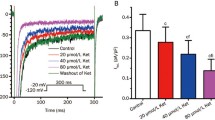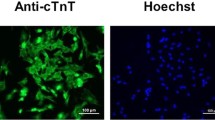Abstract
To explore the cardiovascular protective effects of Magnesium isoglycyrrhizinate (MI), especially the underlying cellular mechanisms related to L-type calcium channels and myocardial contractility, and to examine the effects of MI on hERG K+ current expressed in HEK293 cells. We used the whole-cell patch clamp technique, video-based edge detection and dual excitation fluorescence photomultiplier systems to explore the effect of MI on L-type Ca2+ currents (ICa-L) and cell contraction in rat cardiomyocytes. We also examined the rapidly activating delayed rectifier potassium current (IKr) expressed in HEK293 cells using a perforated patch clamp. MI inhibited ICa-L in a dose-dependent manner, with a half-maximal inhibitory concentration (IC50) of 0.22 mg/ml, and the maximal inhibitory effect was 61.10 ± 0.59%. MI at a concentration of 0.3 mg/ml reduced cell shortening by 24.12 ± 3.97% and the peak value of the Ca2+ transient by 36.54 ± 4.96%. MI had no significant influence on hERG K+ channels expressed in HEK293 cells at all test potentials. MI exerts protective effects on the heart via the inhibition of ICa-L and cell shortening in rat cardiomyocytes. However, MI had no significant influence on IKr; thus, MI may exert cardioprotective effects without causing drug-induced long QT syndrome.









Similar content being viewed by others
References
Adamcova M, Sterba M, Simunek T, Potacova A, Popelova O, Gersl V (2006) Myocardial regulatory proteins and heart failure. Eur J Heart Fail 8(4):333–342
Balaban RS (2002) Cardiac energy metabolism homeostasis: role of cytosolic calcium. J Mol Cell Cardiol 34(10):1259–1271
Bers DM (2002) Cardiac excitation–contraction coupling. Nature 415(6868):198–205
Bristow MR, Kantrowitz NE, Ginsburg R, Fowler MB (1985) β-Adrenergic function in heart muscle disease and heart failure. J Mol Cell Cardiol 17(1):41–52
Cannell MB, Lederer W (1987) Effect of membrane potential changes on the calcium transient in single rat cardiac muscle cells. Science 238(4832):1419–1423
Chen X, Zhang X, Kubo H, Harris DM, Mills GD, Moyer J, Berretta R, Potts ST, Marsh JD, Houser SR (2005) Ca2+ influx-induced sarcoplasmic reticulum Ca2+ overload causes mitochondrial-dependent apoptosis in ventricular myocytes. Circ Res 97(10):1009–1017
Chen KJ, Chen WY, Chen X, Jia YM, Peng GQ, Chen L (2014) Increased elimination of paclitaxel by magnesium isoglycyrrhizinate in epithelial ovarian cancer patients treated with paclitaxel plus cisplatin: a pilot clinical study. Eur J Drug Metab Pharmacokinet 39(1):25–31
Chouabe C, Drici MD, Romey G, Barhanin J, Lazdunski M (1998) hERG and KvLQT1/IsK, the cardiac K+ channels involved in long QT syndromes, are targets for calcium channel blockers. Mol Pharmacol 54(4):695–703
Cleemann L, Morad M (1991) Role of Ca2+ channel in cardiac excitation-contraction coupling in the rat: evidence from Ca2+ transients and contraction. J Physiol 432(1):283
Crystal GJ, Silver JM, Salem MR (2013) Mechanisms of increased right and left ventricular oxygen uptake during inotropic stimulation. Life Sci 93(2–3):59–63
Doggrell SA (2005) Has the controversy over the use of calcium channel blockers in coronary artery disease been resolved? Expert Opin Pharmacother 6(5):831–834
Dong L, Yu F, Liu J, Mu X (2006a) Protective effect of magnesium isoglycyrrhizina on acute hepatic injury in mice. China Pharm 17(12):902–904
Dong MQ, Lau CP, Gao Z, Tseng GN, Li GR (2006b) Characterization of recombinant human cardiac KCNQ1/KCNE1 channels (IKs) stably expressed in HEK 293 cells. J Membr Biol 210(3):183–192
Frey N, Olson E (2003) Cardiac hypertrophy: the good, the bad, and the ugly. Annu Rev Physiol 65(1):45–79
Gao Y, Zhang K, Zhu F, Wu Z, Chu X, Zhang X, Zhang Y, Zhang J, Chu L (2014) Salvia miltiorrhiza (Danshen) inhibits L-type calcium current and attenuates calcium transient and contractility in rat ventricular myocytes. J Ethnopharmacol 158PA:397–403
Grandi E, Pasqualini FS, Bers DM (2010) A novel computational model of the human ventricular action potential and Ca transient. J Mol Cell Cardiol 48(1):112–121
Guan BC, Zhang HL, Li ZW (2013) Basic principles of cellular electrophysiology and patch clamp techniques, 1st edn. Science Press, Beijing
Holladay JW, Dewey MJ, Yoo SD (1997) Quantification of fluoxetine and norfluoxetine serum levels by reversed-phase high-performance liquid chromatography with ultraviolet detection. J Chromatogr B Biomed Sci Appl 704(1–2):259–263
Kim JG, Sung DJ, Kim HJ, Park SW, Won KJ, Kim B, Shin HC, Kim KS, Leem CH, Zhang YH (2016) Impaired inactivation of L-type Ca2+ current as a potential mechanism for variable arrhythmogenic liability of hERG K+ channel blocking drugs. PLoS ONE 11(3):e0149198
Li XG, Chen Q, Huang M, Ming BI, Chen L (2003) Effect of active components of Zhi Gancao decoction and their combination on triggered activity and myocardial damage in isolated ischemia-reperfusion rat heart. Tradit Chin Drug Res Clin Pharmacol 14(1):6–9
Martin CA, Matthews GD, Huang CL (2012) Sudden cardiac death and inherited channelopathy: the basic electrophysiology of the myocyte and myocardium in ion channel disease. Heart 98(7):536–543
Menown IB, Adgey AJ (2001) Cardioprotective therapy and sodium-hydrogen exchange inhibition: current concepts and future goals. J Am Coll Cardiol 38(6):1651–1653
Ojha S, Golechha M, Kumari S, Bhatia J, Arya DS (2013) Glycyrrhiza glabra protects from myocardial ischemia-reperfusion injury by improving hemodynamic, biochemical, histopathological and ventricular function. Exp Toxicol Pathol 65(1–2):219–227
Piper H, Garcña-Dorado D, Ovize M (1998) A fresh look at reperfusion injury. Cardiovasc Res 38(2):291–300
Poole-Wilson PA, Lubsen J, Kirwan BA, van Dalen FJ, Wagener G, Danchin N, Just H, Fox KA, Pocock SJ, Clayton TC, Motro M, Parker JD, Bourassa MG, Dart AM, Hildebrandt P, Hjalmarson A, Kragten JA, Molhoek GP, Otterstad JE, Seabra-Gomes R, Soler-Soler J, Weber S (2004) Effect of long-acting nifedipine on mortality and cardiovascular morbidity in patients with stable angina requiring treatment (ACTION trial): randomised controlled trial. Lancet 364(9437):849–857
Richard S, Perrier E, Fauconnier J, Perrier R, Pereira L, Gõmez AM, Bénitah JP (2006) ‘Ca2+-induced Ca2+ entry’or how the L-type Ca2+ channel remodels its own signalling pathway in cardiac cells. Prog Biophys Mol Biol 90(1):118–135
Salem KA, Qureshi A, Ljubisavijevic M, Oz M, Isaev D, Hussain M, Howarth FC (2010) Alloxan reduces amplitude of ventricular myocyte shortening and intracellular Ca2+ without altering L-type Ca2+ current, sarcoplasmic reticulum Ca2+ content or myofilament sensitivity to Ca2+ in Wistar rats. Mol Cell Biochem 340(1–2):115–123
Sharma N, Cho DH, Kim SY, Bhattarai JP, Hwang PH, Han SK (2012) Magnesium sulfate suppresses L-type calcium currents on the basilar artery smooth muscle cells in rabbits. Neurol Res 34(3):291–296
Sonnenblick EH, Ross J Jr, Covell JW, Kaiser GA, Braunwald E (1965) Velocity of contraction as a determinant of myocardial oxygen consumption. Am J Physiol 209(5):919–927
ten Tusscher KH, Panfilov AV (2006) Alternans and spiral breakup in a human ventricular tissue model. Am J Physiol 291(3):H1088–H1100
ten Tusscher KH, Noble D, Noble PJ, Panfilov AV (2004) A model for human ventricular tissue. Am J Physiol 286(4):H1573–H1589
Verkerk AO, Wilders R, Schulze-Bahr E, Beekman L, Bhuiyan ZA, Bertrand J, Eckardt L, Lin D, Borggrefe M, Breithardt G, Mannens MM, Tan HL, Wilde AA, Bezzina CR (2005) Role of sequence variations in the human ether-a-go-go-related gene (hERG, KCNH2) in the Brugada syndrome. Cardiovasc Res 68(3):441–453
Woods KL (1991) Possible pharmacological actions of magnesium in acute myocardial infarction. Br J Clin Pharmacol 32(1):3–10
Xiao ZW, Zhang W, Ma L, Qiu ZW (2014) Therapeutic effect of magnesium isoglycyrrhizinate in rats on lung injury induced by paraquat poisoning. Eur Rev Med Pharmacol Sci 18(3):311–320
Xing GX, Li N, Wang T, Yao MY (2003) Advances in studies on flavonoids of licorice. China J Chin Mater Med 28(7):593–597
Zhao M, Feng R, Shao D, Liu S, Lei M, Wang H, Sun X, Guo F, Hu H, Kameyama M, Hao L (2015) Mg2+- dependent facilitation and inactivation of L-type Ca2+ channels in guinea pig ventricular myocytes. J Pharmacol Sci 129(3):143–149
Zhou CZ, Zhang DL, Wang T (2007) Effect of serum containing Zhigancao decoction on L-type calcium current in isolated single rabbit’s ventricular myocyte. J Beijing Univ tradit Chin Med 28(7):468–471
Acknowledgements
This work was supported by the Research Foundation of Administration of Traditional Chinese Medicine of Hebei Province, China (Nos. 2017007 and 2015030), Research Foundation of Education Bureau of Hebei Province (QN20131046 to X.Z.), and Key Basic Applied Project of Hebei Provincial Department of Science & Technology (No. 15967730D to W.Z.).
Author information
Authors and Affiliations
Corresponding authors
Ethics declarations
Conflict of interest
The authors declare that there are no conflicts of interest.
Additional information
Yue Lin and Yuanyuan Zhang contributed equally to this work.
Rights and permissions
About this article
Cite this article
Lin, Y., Zhang, Y., Song, Q. et al. Magnesium isoglycyrrhizinate inhibits L-type Ca2+ channels, Ca2+ transients, and contractility but not hERG K+ channels. Arch. Pharm. Res. 40, 1135–1145 (2017). https://doi.org/10.1007/s12272-017-0938-6
Received:
Accepted:
Published:
Issue Date:
DOI: https://doi.org/10.1007/s12272-017-0938-6




